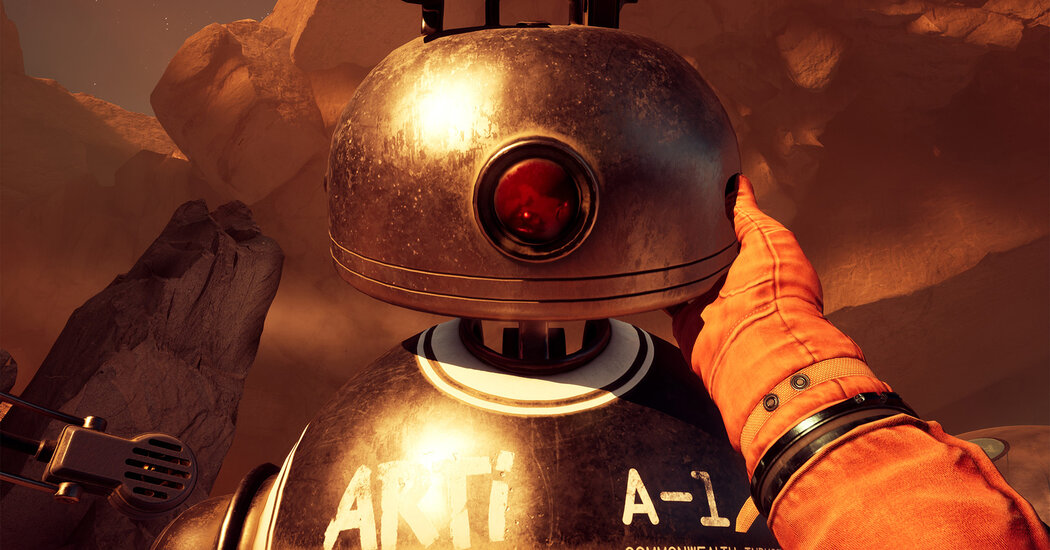Humanity’s first contact with tiny quasi-intelligent robots felt fresh and believable to the video game producer Marek Markuszewski as he devoured “The Invincible,” Stanislaw Lem’s 1964 science fiction novel, in two evenings. Its precise descriptions of force fields and antimatter cannons seemed ready-made for the screen.
“This is great material for a major game,” Markuszewski said he thought at the time, while he was working for the developer CD Projekt Red. “Why hasn’t anyone done it already?”
Although movies and TV shows frequently transplant from the page — Oscar contenders this year include the adaptations “Poor Things,” “American Fiction” and “The Zone of Interest” — it is rare for video games to directly draw from books. But it was a challenge Markuszewski embraced after cofounding the Polish studio Starward Industries, which has adapted Lem’s work for its debut game, The Invincible. (It releases on Monday for the PC, the PlayStation 5 and the Xbox Series X|S.)
Markuszewski had some key experience as a producer on The Witcher 3: Wild Hunt, which is based on the fantasy novels by Andrzej Sapkowski, and knew telling an unaltered version of Lem’s story would not work.
Books and games, he said, use different pacing and perspectives to build their narratives. Lem switches from inside the head of his main character, Rohan, to describing a crew descending a spaceship’s ramp as if the reader were dangling overhead. “We can’t do that,” Markuszewski said.
Ultimately, Starward decided to create an original character — Yasna, a female crew member of a research ship who begins the game alone with amnesia — while following the book’s rough structure. Markuszewski likens it to a slow detective novel that simultaneously unravels the mystery of an alien life force and the fate of a missing crew.
The themes of “The Invincible,” including the limits of human understanding, were broad enough to let Starward dig deeper. Markuszewski wanted to match the book’s philosophy, too, and the game is being marketed with a quote about the dangers of human expansionism: “Not everything everywhere is for us.”
One advantage of video games is that the player can manipulate the environment and make narrative-altering choices. And connecting the player with the protagonist defines every decision that Starward made.
It built bespoke first-person animations so the player can see Yasna’s hands hit switches, fiddle with keys and hold clunky scanners with green monochrome displays. The slim oxygen masks from the book are replaced by heavy domed helmets, with Yasna’s breath steaming up the screen in frantic moments.
In the game’s demo, Yasna approaches a mobile antimatter cannon that looks like a hulking, metallic spider in an infantry helmet. She yanks open a squeaky flap on its base, twists a worn handle and punches a red button before the cannon’s camera spits out photos.
More tangible still is the player’s ability to determine Yasna’s fate. How do you treat the captain on the other end of your radio and, more important, the alien presence on the planet. Flee? Fight? Study it?
It is a narrative tightrope for Starward because the game’s multiple endings must reflect players’ decisions while also honoring Lem’s original, somewhat ambiguous finale.
“All the endings fit the framing of the book, in terms of its philosophy,” Markuszewski said. “There are some different facts, but that doesn’t matter.”
Any developer that adapts a book faces similar challenges about giving players agency without disregarding the source material.
Deck Nine Games and Telltale Games selected the morally ambiguous Camina Drummer from nine lengthy books (and the television series they spawned) to lead The Expanse: A Telltale Series, which began releasing episodes in July.
“She will do the right thing, usually, but also she is not afraid to hurt people,” said Stephan Frost, the game director at Deck Nine.
Choices are not the only way to give players agency, Frost explained. Dropping them into an action scene can have the same effect. When his team found a zero-gravity Brazilian jujitsu match in one of the “Expanse” books by Daniel Abraham and Ty Franck, it built the setting and handed players the controls.
“What makes games fun, at least to me, is getting to do things that I don’t get to do normally,” Frost said. “It’s fantasy fulfillment.”
In The Invincible, that fantasy includes exploring a mysterious sandy planet in a yellow rover that is half dune buggy, half camper van, with antennas reaching skyward like an ant’s feelers. The visual design draws on Lem’s retrofuturism and classic sci-fi illustrators such as Chris Foss and Syd Mead.
Starward’s first game may be many players’ introduction to Lem, who is perhaps best known for “Solaris,” which inspired the 1972 movie by Andrei Tarkovsky. But creating The Invincible has shown Markuszewski what types of games he wants to continue making. Ones where seemingly insignificant moments — steering through rocky valleys or pressing buttons — matter.
“Not everything is about criminals, horror, big guns, murder,” he says. “The small things matter. They fill our lives, and if you create them with respect and with love, they are good.”

